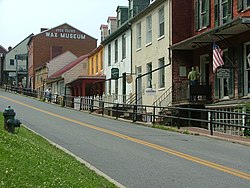Harpers Ferry Historic District
Harpers Ferry Historic District | |
 | |
| Location | Harpers Ferry, West Virginia |
|---|---|
| Coordinates | 39°19′35″N 77°44′29″W / 39.32639°N 77.74139°W |
| Built | 1800 |
| Architect | Multiple |
| Architectural style | Late Victorian |
| NRHP reference No. | 79002584 |
| Added to NRHP | October 15, 1979[1] |
The Harpers Ferry Historic District comprises about one hundred historic structures in
In the late 19th century a number of
The historic district preserves what is essentially an intact 19th-century town that occupied a pivotal role in the American Civil War, and later as a transportation center. Thousands of tourists visit the town every year, however, parking in town is scarce. In order to better manage traffic in the small streets and enhance the feel of this historic town visitors are asked to park at the nearby Visitors Center and take the Park Service bus into the town itself. Taking the bus gives visitors a view of the traditional infrastructure that made Harpers Ferry so important prior to the 20th century.
A commuter train line stops at Harpers Ferry's historic train station and links the town with Washington, D.C., with many intermediate stops.[2]
The town was severely damaged during the Civil War, and the Armory, the only large employer, was destroyed; the only surviving building is the fire engine house, called John Brown's Fort, which is not at its original location (it traveled to Chicago and back). In addition, there was repetitive flooding in the late 19th and early 20th centuries. in the inadvertent preservation of much of the original town fabric. Two National Register properties adjoin the Harpers Ferry Historic District—the B & O Railroad Potomac River Crossing and St. Peter's Roman Catholic Church.
See also
- National Register of Historic Places listings in Jefferson County, West Virginia
- Harpers Ferry National Historical Park
References
- ^ "National Register Information System". National Register of Historic Places. National Park Service. April 15, 2008.
- ^ Harpers Ferry Planning Commission (November 1, 1978). "National Register of Historic Places Nomination: Harpers Ferry Historic District" (PDF). National Park Service.
{{cite journal}}: Cite journal requires|journal=(help)
External links
- Historic American Buildings Survey (HABS) No. WV-224, "Harpers Ferry National Historical Park, General Views, Shenandoah Street, Harpers Ferry, Jefferson County, WV", with many other entries for individual buildings



